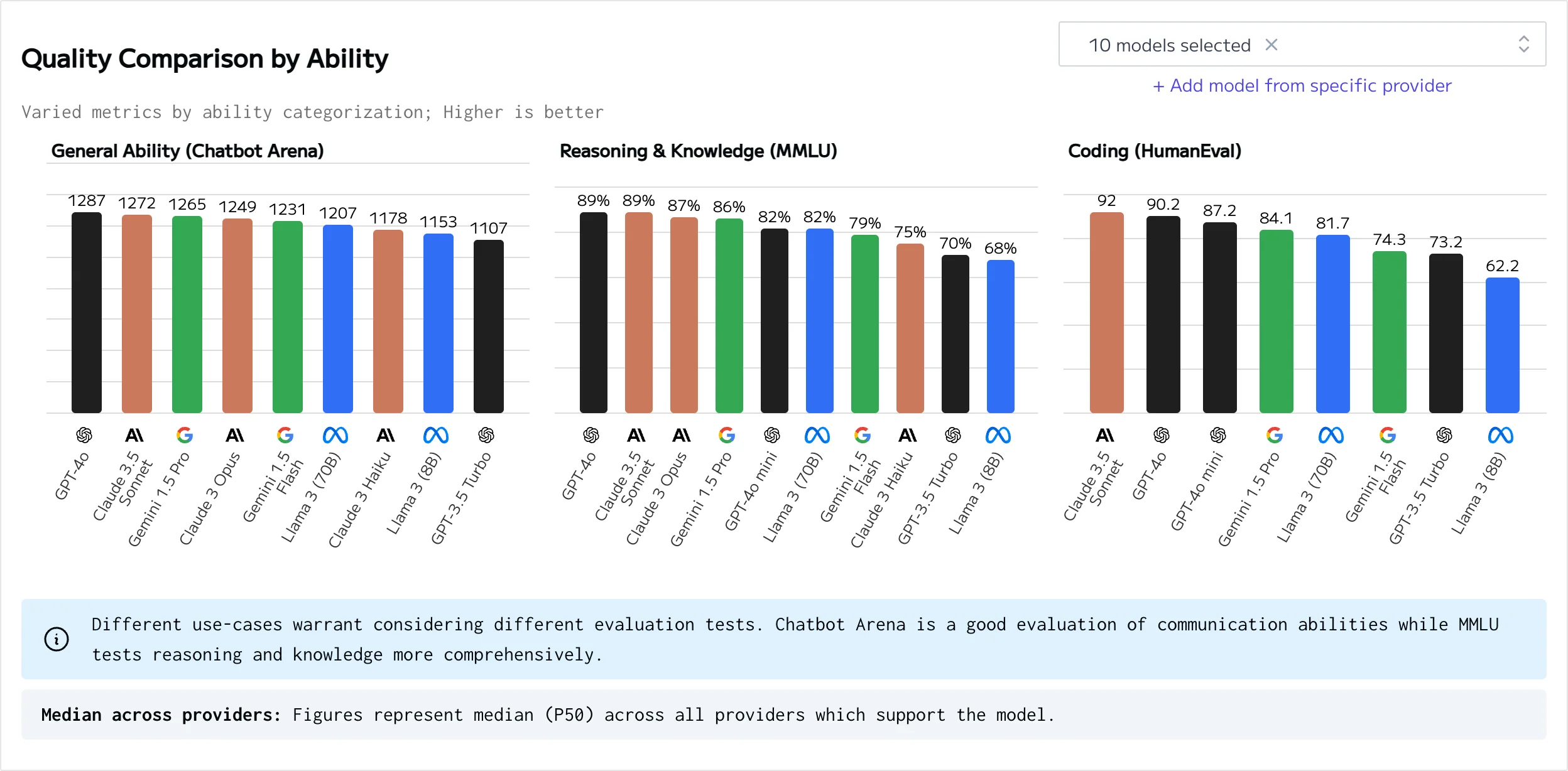Contents
ToggleKey Takeaways
- Efficiency and Accessibility: GPT-4o mini offers advanced AI capabilities with a reduced resource footprint, making sophisticated AI technology more accessible to a broader audience, including startups and small businesses.
- Competitive Performance: Despite its compact size, the new model delivers strong performance across various tasks, including text generation, reasoning, knowledge, and coding, making it a versatile option for diverse applications.
- General Ability: In the Chatbot Arena, it demonstrates robust general conversational skills, making it suitable for interactive applications requiring quick and accurate responses.
- Reasoning and Knowledge: GPT-4o mini scores highly in reasoning and knowledge tests (MMLU), showcasing its ability to handle complex tasks requiring deep understanding and logical reasoning.
- Cost-Effectiveness: The lower computational requirements of GPT-4o mini translate to cost savings, making advanced AI more affordable for a wider range of users and applications.
- Future of AI: GPT-4o mini represents a significant step towards democratizing AI, providing a powerful tool that balances performance with efficiency, paving the way for broader adoption and innovation in AI technology.
In an era where artificial intelligence (AI) continues to redefine the boundaries of technology, the launch of GPT-4o mini stands as a remarkable milestone. This compact yet powerful version of the GPT-4 architecture brings the sophistication of advanced AI to a broader audience, promising to transform how we interact with machines and leverage their capabilities across various domains.
The Evolution of GPT Models
The GPT (Generative Pre-trained Transformer) series, developed by OpenAI, has been at the forefront of AI innovation. From GPT-2, which amazed the world with its text generation capabilities, to GPT-3, which brought unprecedented levels of language understanding and generation, each iteration has pushed the envelope further. GPT-4 continued this trajectory, enhancing performance, coherence, and applicability in numerous fields, including natural language processing, machine learning, and data analysis.
What is GPT-4o mini?
GPT-4o mini is a streamlined version of the GPT-4 model, designed to deliver powerful AI capabilities in a more compact, efficient, and accessible package. While retaining the core strengths of its predecessor, it focuses on optimizing computational efficiency and reducing resource requirements, making it ideal for a wide range of applications, from mobile devices to edge computing environments.
Key Features:
- Efficiency and Speed: GPT-4o mini is engineered for high performance with minimal latency, ensuring quick responses even on less powerful hardware. This makes it suitable for real-time applications where speed is crucial.
- Reduced Resource Footprint: By leveraging advanced optimization techniques, it requires significantly fewer computational resources, making it more accessible for developers and businesses with limited infrastructure.
- Versatility: Despite its smaller size, GPT-4o mini maintains a high level of versatility, capable of handling various tasks such as text generation, summarization, translation, and more. Its adaptability ensures it can be integrated into diverse use cases.
- Cost-Effectiveness: Lower resource requirements translate to cost savings, making sophisticated AI technology more affordable for startups, small businesses, and individual developers.
- Enhanced Accessibility: With its reduced footprint and efficient design, it is poised to democratize access to advanced AI, enabling more people and organizations to harness its potential.
GPT-4o vs. GPT-4o mini: A Comparative Analysis
Choosing between GPT-4o and GPT-4o mini depends on your specific needs and resources. Both advanced AI models, cater to different needs.
GPT-4o offers top-tier performance for large-scale applications, while GPT-4o mini provides a cost-effective, efficient solution for startups, small businesses, and individual developers. This comparison highlights their unique features and advantages, guiding users to make informed choices based on their specific requirements.
- Cost Efficiency:
- GPT-4o: As a full-scale model, it offers advanced AI capabilities but at a higher operational cost, making it more suitable for large enterprises with substantial computational resources.
- GPT-4o mini: Priced at 15 cents per million input tokens and 60 cents per million output tokens, GPT-4o mini is over 60% cheaper than GPT-3.5 Turbo. This significant cost reduction makes it ideal for startups, small businesses, and individual developers looking to leverage AI technology affordably.
- Performance:
- GPT-4o: Known for its extensive capabilities and high performance across various benchmarks, it can handle extremely complex tasks and generate high-quality outputs. However, it requires substantial computational power and infrastructure.
- GPT-4o mini: Offers a context window of 128,000 tokens and can generate up to 16,000 tokens of output. It performs exceptionally well in benchmarks, scoring 82% on the MMLU (Massive Multitask Language Understanding) test, outperforming models like Gemini Flash and Claude Haiku. While slightly less powerful than GPT-4o, it provides a balanced performance suitable for many applications with less demanding infrastructure requirements.
- Capabilities:
- GPT-4o: Supports a wide range of inputs and outputs, including text, vision, audio, and video, making it extremely versatile for diverse applications in various industries.
- GPT-4o mini: Currently supports both text and vision inputs, with future plans to expand to audio and video functionalities. It is designed to handle tasks such as coding, mathematical reasoning, and customer support, showcasing its adaptability and robustness.
- Application Suitability:
- GPT-4o: Best suited for enterprises and large-scale projects that require high-level AI capabilities and have the resources to support its computational needs. It excels in environments where maximum performance and versatility are paramount.
- GPT-4o mini: Tailored for smaller-scale applications, it is perfect for developers, small businesses, and educational purposes. Its cost-effectiveness and efficient performance make it accessible for those with limited resources, without sacrificing significant capability.
- Accessibility:
- GPT-4o: While highly capable, the resource requirements and cost can be prohibitive for many users, limiting its accessibility to those with substantial budgets.
- GPT-4o mini: Designed to democratize access to advanced AI, its lower resource requirements and affordable pricing open up sophisticated AI technology to a wider audience, enabling more innovative uses and broader adoption.
Both GPT-4o and GPT-4o mini offer powerful AI capabilities, but they cater to different needs and audiences. GPT-4o is ideal for large enterprises and projects requiring the highest level of performance and versatility. In contrast, GPT-4o mini provides a more cost-effective, accessible solution, making it perfect for startups, small businesses, and individual developers seeking to integrate advanced AI into their applications without the associated high costs.
Understanding the Quality Comparison Graphs

The quality comparison graphs provide a detailed analysis of various AI models based on their abilities in three distinct categories: General Ability (Chatbot Arena), Reasoning & Knowledge (MMLU), and Coding (HumanEval). Here’s a breakdown of what each graph represents and how GPT-4o mini compares to other popular models:
General Ability (Chatbot Arena)
This graph measures the overall performance of AI models in a simulated chatbot environment, evaluating their communication abilities across various scenarios.
- GPT-4 leads the pack with a score of 1287, indicating its superior general ability in handling diverse conversational contexts.
- GPT-4o mini holds a respectable position with a score of 1182, demonstrating strong performance while being more resource-efficient compared to its larger counterparts.
- Other notable models include Claude 3.5 Comet, Claude 3.5 Opus, and Gemini 1.5 Flash, all performing well in this category.
Reasoning & Knowledge (MMLU)
This graph evaluates the reasoning and knowledge capabilities of AI models using the Massive Multi-Task Language Understanding (MMLU) benchmark, which tests models on a wide range of tasks requiring deep understanding and reasoning.
- GPT-4 and Claude 3.5 Comet both achieve the highest score of 89%, showcasing their advanced reasoning and comprehensive knowledge base.
- GPT-4o mini scores 82%, indicating robust reasoning and knowledge capabilities, making it a competitive option despite its compact size.
- Other high performers in this category include Claude 3.5 Opus and Gemini 1.5 Pro.
Coding (HumanEval)
This graph assesses the coding abilities of AI models based on the HumanEval benchmark, which involves generating correct code for given problems.
- Claude 3.5 Sonnet takes the lead with a score of 92, highlighting its exceptional coding skills.
- GPT-4 follows closely with a score of 90.2, reflecting its proficiency in coding tasks.
- GPT-4o mini scores 87.2, demonstrating its capability to handle coding tasks efficiently.
- Models like Gemini 1.5 Pro and Llama 3 (70B) also show strong performance in coding, albeit at a lower scale compared to the leading models.
Potential Applications
The launch of GPT-4o mini opens up new possibilities across multiple sectors:
- Education: Interactive educational tools and personalized learning experiences can benefit from its capabilities, providing students with instant assistance and tailored content.
- Healthcare: Medical professionals can use it to assist with patient consultations, data analysis, and research, enhancing the efficiency and accuracy of healthcare services.
- Customer Service: Businesses can improve customer support, offering faster and more accurate responses, thereby enhancing customer satisfaction.
- Content Creation: Writers, marketers, and content creators can generate high-quality content, brainstorm ideas, and automate repetitive tasks, boosting productivity.
- IoT and Smart Devices: The compact nature makes it ideal for integration into IoT devices, enabling smarter homes, cities, and industries with advanced AI-driven functionalities.
Key Features and Pricing of GPT-4o mini
Cost Efficiency: Offering significant cost savings, priced at just 15 cents per million input tokens and 60 cents per million output tokens. This pricing is over 60% cheaper than GPT-3.5 Turbo, making it an attractive option for developers aiming to incorporate AI into their applications without incurring high costs.
Performance: With a context window of 128,000 tokens and the ability to generate up to 16,000 tokens of output, it delivers impressive performance. It excels in various benchmarks, achieving a score of 82% on the MMLU (Massive Multitask Language Understanding) test, surpassing competitors like Gemini Flash and Claude Haiku.
Capabilities: Supports both text and vision inputs, with future plans to extend its capabilities to include audio and video functionalities. It is designed to tackle a wide array of tasks, such as coding, mathematical reasoning, and customer support, demonstrating its versatility and robustness across different applications.
The Future of AI with GPT-4o mini
The introduction marks a significant step towards making advanced AI more accessible and practical. As AI continues to evolve, the emphasis on efficiency, versatility, and accessibility will likely shape the development of future models, setting a new standard for what is possible with AI technology.
In conclusion, GPT-4o mini is a testament to the relentless innovation in the field of artificial intelligence. By bringing the power of GPT-4 into a more compact and efficient form, it paves the way for broader adoption and novel applications, ultimately pushing the boundaries of what AI can achieve in our everyday lives.
TL;DR
GPT-4o mini offers cost-effective AI capabilities, priced at 15 cents per million input tokens and 60 cents per million output tokens, over 60% cheaper than GPT-3.5 Turbo.
- Performance: With a context window of 128,000 tokens and up to 16,000 tokens output, it scores 82% on the MMLU test, outperforming many competitors.
- Versatility: Supports text and vision inputs, with plans to expand to audio and video. Suitable for coding, reasoning, and customer support tasks.
- Accessibility: Designed for startups, small businesses, and individual developers, making advanced AI more accessible and affordable.
- Comparison: GPT-4o offers higher performance for large-scale applications, while GPT-4o mini is ideal for smaller-scale, cost-sensitive projects.
- Applications: Education, healthcare, customer service, content creation, and IoT integration.
Continue reading ↘
Season’s Greetings
December 20, 2012
Multi-factor authentication and why you need it
March 31, 2013
Introducing our new website
March 31, 2013
Goodbye 2016. Hello 2017.
December 19, 2016
It’s 2018. Happy New Year.
January 1, 2018
Identify trends that can stimulate small business growth
August 17, 2018






